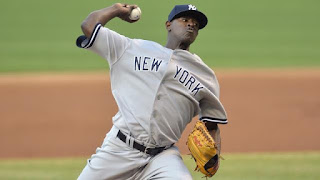Aroldis Chapman is back to being the top closer in the majors
The pinstriped career of
Aroldis Chapman has had its ups-and-downs. When Brian Cashman went out and
traded for the hard-throwing left-hander, Yankees fans thought he, along with
fellow-lefty Andrew Miller, were the missing pieces needed for another World
Series run. But the veterans broke down, the prospects weren’t ready, and it
was the Chicago Cubs that Chapman would help lead to a World Series title in
2016 (but not before the Yankees received a certain middle-infielder by the
name of Gleyber Torres in exchange). When he entered free agency again after
2016, Cashman jumped at the opportunity to bring the elite closer back to the
Bronx in hopes of a playoff berth. While the Yankees did make it to the ALCS in
2017, the season ended up being one of the worst of Chapman’s career. After a
few minor injuries, trouble with command, and building up his breaking pitch,
Aroldis Chapman is back to being one of the most-feared relievers in baseball
in 2018.
 |
| Photo Credit: MLB.com |
While it was by no means a bad
year by conventional standards, 2017 was a smudge on the legacy of the Cuban
southpaw. Posting a 3.22 ERA in 52 appearances, it was just the second time in
his career that Chapman had posted an ERA over 3.00 (the first since his first
full Major League season in 2011). More concerning were Chapman’s occasional
struggles with command. He walked 20 batters in 50.1 innings, typically
compounding those walks in separate appearances. Sometimes Chapman was
absolutely dominating, and sometimes Yankees fans would have to watch his save
attempts with hands over their eyes, hoping he could find the glove and get
some swings and misses before walking in the tying or winning runs.
It’s hard to complain about a
guy who only blows four saves while locking down 22, but when combined with the
fact that Chapman dealt with minor injuries throughout the year that shelved
him with D.L. stints, Yankees fans were concerned. Moreover, Chapman is
currently the third-highest paid reliever in baseball, while his stats were
relatively middle-of-the road for closers. Coming into 2018, no one really knew
what the Yankees would get from Chapman. Would he be the flamethrower who
struck fear in the hearts of opposing batters, or did Joe Maddon and company do
their part to destroy Chapman’s arm through shear work-load down the stretch in
2016? Luckily for Yankees fans, the answer appears to be the former.
Now posting a 1.30 ERA with 17
saves already under his belt, Chapman appears to be back to form. At the same
time, though, Chapman looks different than when he was dominating the N.L. with
the Cincinnati Reds and the Cubs. Perhaps due to the fact that a large part of
Chapman’s recent success has been his lack of reliance on his 100-plus m.p.h.
fastball and more faith in his wipeout slider. Chapman began featuring his
breaking pitch more in 2016, and now he throws it just slightly less-often that
his premiere heater. He has started going to the slide-piece when he loses
command of his fastball, and typically to great success. Chapman has shown the
ability to dot the outside corner with the pitch to righties and get lefty’s to
chase it out of the zone. This pitch is a big part of the reason his K/9 ratio
(15.6) is the highest it’s been since he was an All-Star in 2015. While Chapman
is still walking batters at a concerning clip (4.2 BB/9, also his highest since
2015), he’s allowing his fewest H/9 (4.2) since 2014.
 |
| Photo Credit: Adam Hunger | AP |
Whether it’s the development of
his secondary pitches, confidence, or finally being healthy, Aroldis Chapman
appears to be the same guy that netted New York one of the best young players
in the game back in 2016. This is music to a Yankees fans ears, as Chapman is
under contract through at least next season, with options that could keep him
in Pinstripes through 2021. Now all that’s left is for him to help bring a
World Series trophy back to the Bronx, but given his recent success Chapman
does not appear to be the part of that formula the fans should be concerned
about.
Article by: Jonathan Kohut


Comments
Post a Comment